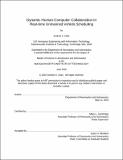| dc.contributor.advisor | Mary L. Cummings. | en_US |
| dc.contributor.author | Clare, Andrew S | en_US |
| dc.contributor.other | Massachusetts Institute of Technology. Dept. of Aeronautics and Astronautics. | en_US |
| dc.date.accessioned | 2010-10-29T13:49:47Z | |
| dc.date.available | 2010-10-29T13:49:47Z | |
| dc.date.copyright | 2010 | en_US |
| dc.date.issued | 2010 | en_US |
| dc.identifier.uri | http://hdl.handle.net/1721.1/59555 | |
| dc.description | Thesis (S.M.)--Massachusetts Institute of Technology, Dept. of Aeronautics and Astronautics, 2010. | en_US |
| dc.description | This electronic version was submitted by the student author. The certified thesis is available in the Institute Archives and Special Collections. | en_US |
| dc.description | Cataloged from student submitted PDF version of thesis. | en_US |
| dc.description | Includes bibliographical references (p. 123-127). | en_US |
| dc.description.abstract | Advances in autonomy have made it possible to invert the operator-to-vehicle ratio so that a single operator can control multiple heterogeneous Unmanned Vehicles (UVs). This autonomy will reduce the need for the operator to manually control each vehicle, enabling the operator to focus on higher-level goal setting and decision-making. Computer optimization algorithms that can be used in UV path-planning and task allocation usually have an a priori coded objective function that only takes into account pre-determined variables with set weightings. Due to the complex, time-critical, and dynamic nature of command and control missions, brittleness due to a static objective function could cause higher workload as the operator manages the automation. Increased workload during critical decision-making could lead to lower system performance which, in turn, could result in a mission or life-critical failure. This research proposes a method of collaborative multiple UV control that enables operators to dynamically modify the weightings within the objective function of an automated planner during a mission. After a review of function allocation literature, an appropriate taxonomy was used to evaluate the likely impact of human interaction with a dynamic objective function. This analysis revealed a potential reduction in the number of cognitive steps required to evaluate and select a plan, by aligning the objectives of the operator with the automated planner. A multiple UV simulation testbed was modified to provide two types of dynamic objective functions. The operator could either choose one quantity or choose any combination of equally weighted quantities for the automated planner to use in evaluating mission plans. To compare the performance and workload of operators using these dynamic objective functions against operators using a static objective function, an experiment was conducted where 30 participants performed UV missions in a synthetic environment. Two scenarios were designed, one in which the Rules of Engagement (ROEs) remained the same throughout the scenario and one in which the ROEs changed. The experimental results showed that operators rated their performance and confidence highest when using the dynamic objective function with multiple objectives. Allowing the operator to choose multiple objectives resulted in fewer modifications to the objective function, enhanced situational awareness (SA), and increased spare mental capacity. Limiting the operator to choosing a single objective for the automated planner led to superior performance for individual mission goals such as finding new targets, while also causing some violations of ROEs, such as destroying a target without permission. Although there were no significant differences in system performance or workload between the dynamic and static objective 4 functions, operators had superior performance and higher SA during the mission with changing ROEs. While these results suggest that a dynamic objective function could be beneficial, further research is required to explore the impact of dynamic objective functions and changing mission goals on human performance and workload in multiple UV control. | en_US |
| dc.description.statementofresponsibility | by Andrew S. Clare. | en_US |
| dc.format.extent | 127 p. | en_US |
| dc.language.iso | eng | en_US |
| dc.publisher | Massachusetts Institute of Technology | en_US |
| dc.rights | M.I.T. theses are protected by
copyright. They may be viewed from this source for any purpose, but
reproduction or distribution in any format is prohibited without written
permission. See provided URL for inquiries about permission. | en_US |
| dc.rights.uri | http://dspace.mit.edu/handle/1721.1/7582 | en_US |
| dc.subject | Aeronautics and Astronautics. | en_US |
| dc.title | Dynamic human-computer collaboration in real-time unmanned vehicle scheduling | en_US |
| dc.type | Thesis | en_US |
| dc.description.degree | S.M. | en_US |
| dc.contributor.department | Massachusetts Institute of Technology. Department of Aeronautics and Astronautics | |
| dc.identifier.oclc | 668108941 | en_US |
